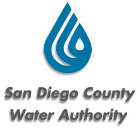
The San Diego County Water Authority (SDCWA) is a public agency serving the San Diego region as a wholesale supplier of water from the Colorado River and Northern California. The Water Authority works through its 24 member agencies to provide a safe, reliable water supply to over three million county residents.

SDCWA sells water at wholesale rates to its member agencies to meet water demands that the agencies are not able to meet using their own, local supplies. Simply put, the Authority imports water from two major sources--the Colorado River Aqueduct and the Metropolitan Water District of Southern California--and distributes this water through a complex network of pipes and other hydraulic structures to its member agencies.
In the past, the Authority charged each member agency the same rate for a unit of delivered water. This "postage stamp" rate structure ignored the fact that each member agency uses different parts of the Authority's facilities. An agency located near one of the Authority's intake points was charged the same rate as an agency that was at the terminus of an extensive network of pipes, canals and storage facilities.
While such a pricing arrangement might very well be considered "equitable," the Authority was interested in examining how their pricing might change if they took into account exactly how much of their distribution system each agency was actually using. They could then use this information to better inform a debate over pricing.

We examined two fundamental approches to the problem of allocating network costs among member agencies: a) use the actual cost of each section of pipe or other asset used by the agency, or b) calculate a cost based on an "idealized" network that is perfectly optimized to meet each agency's peak demand requirements and no more. We opted for approach (b) on the premise that an agency should not be penalized for facilities the Authority built but that are not directly related to serving that agency.
Cross River Software designed a special-purpose application called NetShare to model an idealized network in which the capacity of each segment is matched to the peak demand requirements of all users downstream of the segment. After determining these optimal capacities, NetShare calculates the diameter of each pipe segment based on the hydraulic characteristics of the system, from which an agency's network cost can be calculated.